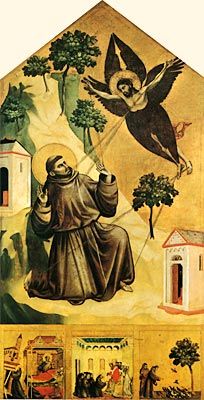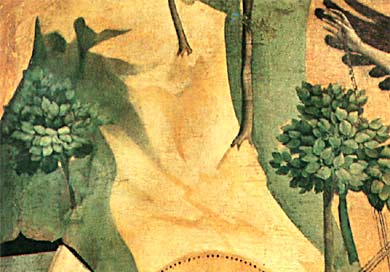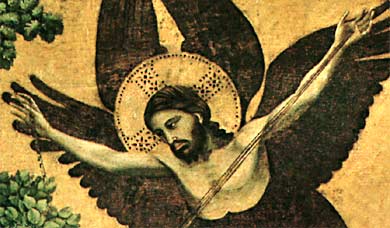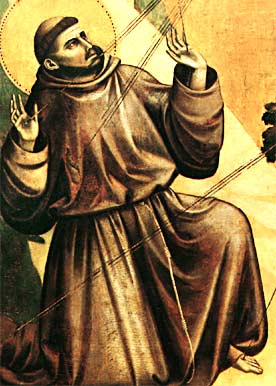
Giotto di Bondone
Stigmatization of St. Francis

"When I see the Giotto frescoes...I immediately understand the feeling that emerges...for it is in the lines, the composition, the color."
≈ Henri Matisse, upon seeing Giotto's frescoesduring a 1907 trip to Padua
Giotto di Bondone (1266 - 1337) was a Florentine painter and architect, whose towering influence is considered to have freed Western art from stylized, Byzantine traditions and set a course toward the full-blooded characters and scenes of the Renaissance. Though he dealt largely with sacred themes, he was the first to depict human emotion, creating scenes of people in crises and making soul-searching decisions with eyes and faces full of fear, hope, rage and love. His techniques gave the stories a naturalism and moral weight rather than focusing on a show of heavenly splendor.
Giotto was born into a farming family in the village of Vespignano, near Florence. Among his legends is the story that the master painter Cimabue, walking in the hills, saw the young Giotto sketching sheep on a flat rock, recognized the 10-year-old's precocious talent and gave Giotto a position in his Florentine workshop. Another story tells of the boy's early skills: once, when Cimabue had gone out, Giotto painted a fly on the nose of a figure Cimabue was painting. When the master returned, he tried repeatedly to brush away the amazingly lifelike insect.
Giotto came of age in en era of profound social change. As cities grew, a world of merchants, traders and craftsmen displaced traditional agricultural village life. Universities replaced monasteries as centers of learning and culture and writers such Dante and Boccaccio began writing in the vernacular, beginning a movement which stressed the importance of humans and the temporal world in which they lived.
Artists also began to study nature and emotion, depicting figures as recognizable human beings acting out stories 
detail 1: for the first time, religious scenes
depict a naturalistic landscape
in the natural landscape. Among Giotto's innovations were his use of shading to place characters in illuminated, three-dimensional spaces that portrayed the variety of the real world rather than traditional backdrops. He emphasized the physical characteristics of each figure, portraying shape and weight of bodies under heavy clothing by modeling forms using light and shadow. More than any other artist of his time, Giotto's figures seemed alive, physically and emotionally -- he told stories through gestures and expressions of immediacy and conviction.
Described as short and homely, Giotto married twice and raised eight children over his long life. His genius brought him great reknown -- he was a shrewd, prosperous businessman on familiar terms with the pope and a friend of kings. His name, for a time, became the Medieval equivalent of a brand, the word 'giotto' a synonym for 'painter’. Even Michelangelo was to study and make copies of Giotto’s compositions.
Painted in 1300 for the Church of San Francesco in Pisa, The Stigmatization of St. Francis illustrates stories from the life of the saint, who had died only 75 years earlier, and whose teaching about the love of nature and close observation of reality made
detail 2: Christ is given a realistic human body
and connects emotionally with Francis
him a particular inspiration to Giotto. In this signed panel, Giotto uses the realistic human form, space, color, gesture and placement of figures to tell the story in a new, 'humanist' way.
The main panel depicts the saint among the rocks of Mount Alverno receiving the stigmata during a vision of Christ. This well-known event, which took place two years before St. Francis's death, involved the saint's journey into the Apennines with some of his disciples. After forty days of fasting and prayer, he experienced a vision in which, within the rays of a rising sun, Christ appeared as a six-winged seraph (the highest order of angels) and flew toward him, filling him with pleasure. When the vision disappeared, Francis felt sharp pains and found the wounds of the Crucifixion impressed on his body.
Three smaller scenes on the predella depict incidents from St. Francis's life — the Dream of Innocent III, the Confirmation of the Rule, and the Sermon to the Birds.
On the main panel, we see how Giotto addressed the problem of presenting human figures and actions realistically on a flat panel meant to represent three-dimensional space. First, he created a striking vertical format using a towering rock formation which defines the space while narrowing
detail 3: the startled saint's body
has form and weight under his
heavy robes the scope of the action. High on the mountain, Giotto placed Francis's tiny hermitage, while all around he added a landscape of common architectural and natural details in earthly hues which easily coexist beside the heavenly and miraculous. In this way, Giotto introduced humanist elements by showing a world in which the everyday and divine intersect and are of equal importance. In later panels, Giotto introduced earthly blue skies to replace traditional heavenly gold backgrounds.
In addition, the characters take on a physical, three-dimensional presence. Although, like other artists of his day, Giotto lacked specific knowledge of anatomy and perspective, he depicts Francis as solid and earthly, rather than illustrative and symbolic, with a form of correct proportion and mass beneath the heavy folds of his robe. Christ is also given a human body which is both realistic and well-defined.
With an expression of intense awe, the kneeling saint seems startled and raises his hands. Focus is on the locked eyes of the two figures in which Giotto viscerally shows us that Francis has completely taken Christ to himself, an event which assumes physical shape in the appearance of the stigmata.
While Giotto's style became universally admired and imitated, it was nearly a century before Masaccio took the next step forward, experimenting with scientific perspective to portray infinite space on the flat plane. With his revolutionary introduction of earthly life and force to religious themes, Giotto had a profound influence on European art and was the true forerunner of Renaissance painting.
